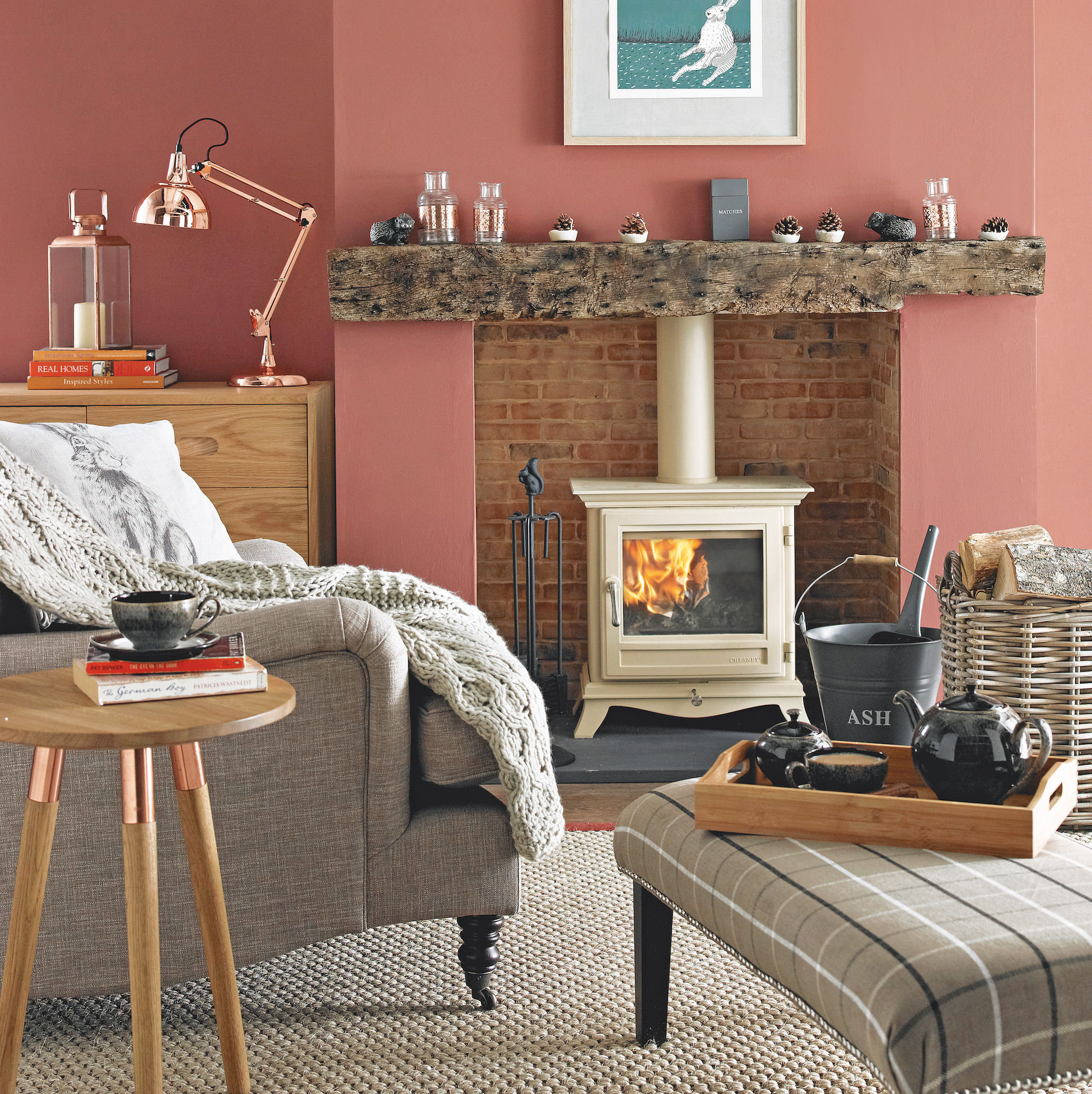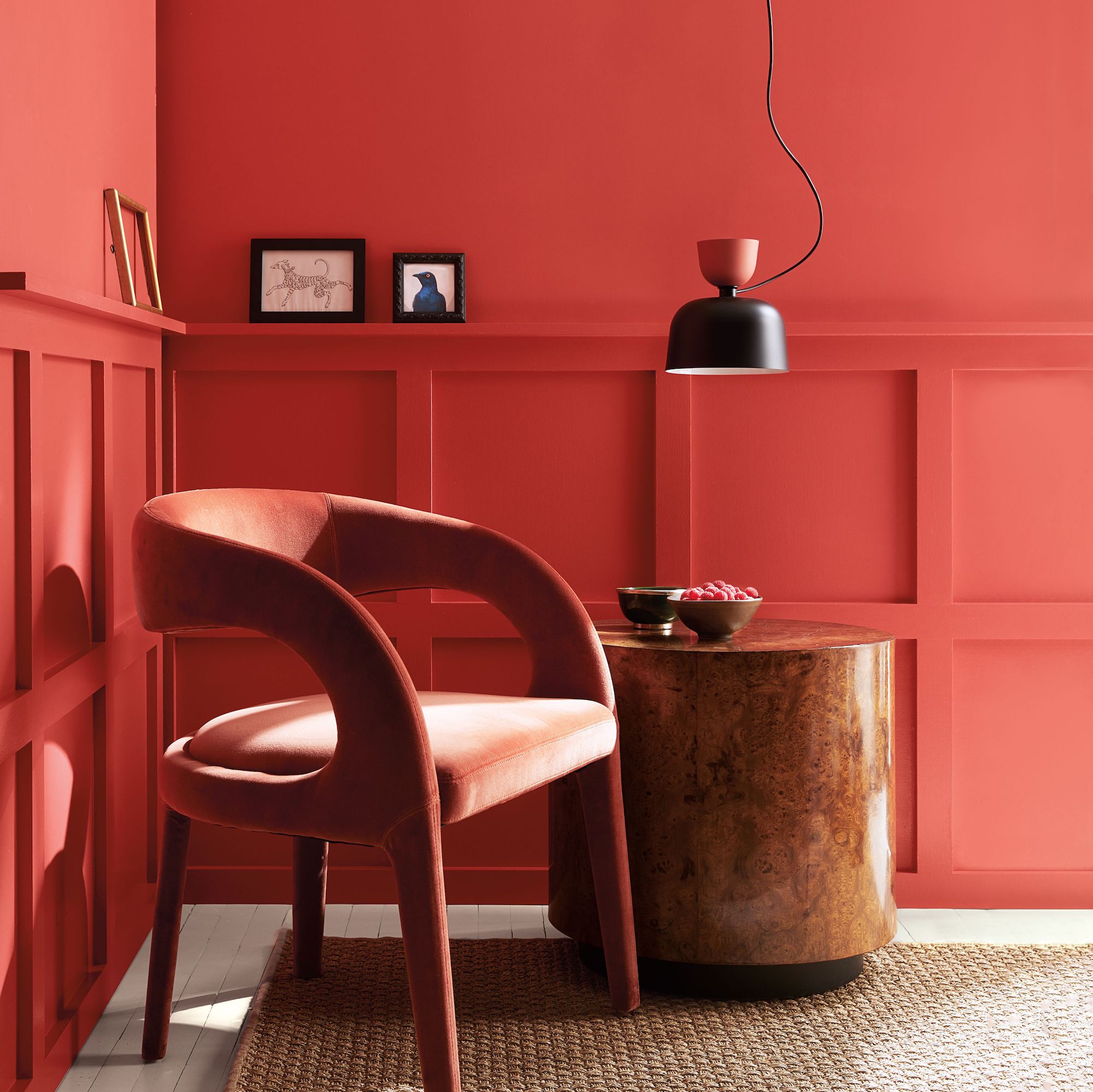How to make a living room feel warmer without turning the heating on
Keep cosy in front of the TV without the fear of a giant energy bill


- 1. Move furniture away from draughty areas
- 2. Seal up any drafts
- 3. Hang thicker curtains
- 4. Choose cosy furniture fabrics
- 5. Think about furniture layout
- 6. Fill gaps in floorboards
- 7. Try a door curtain or draught excluder
- 8. Colour drench your living room
- 9. Choose the right lighting
- 10. Experiment with window film
- FAQs
Tempting as it may be to whack the heating on at this time of year, with the energy costs still high we're all looking at alternative ways to stay warm. How to make a living room feel warmer isn't as hard as it may seem and with a few cosy living room ideas and energy-saving tips, you'll soon feel toasty without having to ramp up the thermostat.
'Creating a living room that feels cosy and warm is at the top of most of our agendas during the winter months,' says Lena Gierasinska, head of product and displays at Barker and Stonehouse. 'The simplest way to add instant warmth to a living room is by layering a variety of cosy textures throughout. Add cosy throws and cushions in tactile fabrics to a sofa – these can be easily stored away as we transition to warmer months.'
How to make a living room feel warmer
Whether you up the comfort factor with cosy throws and living room colour scheme or you tackle some of the more practical elements like sealing up drafts, there are plenty of living room ideas that will keep you warm this winter.
1. Move furniture away from draughty areas

The key to keeping your main room toasty is the placement of your living room seating ideas. Make sure sofas are away from draughty windows and leave space between radiators and furniture, this means the heat is evenly distributed when you do have it on.
'Make sure that nothing is in the way of the heat moving through your room when you’ve got your heating on,' says Melissa Denham, interior design expert at Hammonds Furniture.
'Placing furniture against radiators will actually block the hot air from circulating in your rooms properly and could mean that items close to the radiators or heater will absorb the warmth first.'
2. Seal up any drafts

As winter sets in, set aside a bit of time on a weekend to do a bit of DIY draught proofing so you'll have less heat escaping. 'Drafts can be a significant source of heat loss,' explains Oliver Creevy, managing director and co-founder of Insulation Advisor UK. 'Sealing gaps around windows and doors, using draft stoppers, and ensuring proper insulation are effective ways to block drafts.'
Sign up to our newsletter for style inspiration, real homes, project and garden advice and shopping know-how
3. Hang thicker curtains

A lot of heat is lost via windows so investing in some good-quality window dressings can help a living room feel warmer. 'In winter months we have around 6-8 hours of daylight, on average, which means for the other 18 hours of the day we should consider keeping our curtains and blinds shut,' Helen O’Connor, product manager at 247 Blinds & 247 Curtains .
'Better yet, thermal blinds and curtains are a great way to double up on a thick lining which will retain more heat than thinner materials.'
4. Choose cosy furniture fabrics

Another factor to consider is the type of material your sofa is made of. While leather sofas look stylish they can often be cold when the temperature dips. 'Velvet feels cosy and comfortable and has natural thermal properties so it’s a great choice for those looking to add warmth,' says Shelley Cochrane, accessories buyer at Furniture Village.
'Style your sofa with cushions and throws in complementary shades to instantly add depth and further warmth.'
5. Think about furniture layout

Where you position your furniture can also help to make your living room feel warmer without turning the heating on.
'If your current layout is well spread out, look at moving your living room furniture into a more central point in the room,' explains Charlie English at home furnishing specialists, Woods Furniture.
'This may be set up in front of the fire, television or you could even invest in a coffee table to create a cosy hub. Naturally keeping everyone together within the room will warm the area up and with the addition of cushions and throws you’ll have a much more comforting area to brace the winter in.'
6. Fill gaps in floorboards

If you're lucky enough to have original floorboards in your home, you may find there are a few gaps which can let draughts through in colder times of the year.
'Skirting and floorboards are known to expand and contract due to temperature changes,' explains Ryan Calvert, product expert at Hiatt Hardware. 'To keep the cold air out, we recommend applying hard-setting fillers that are also flexible enough to tolerate movement such as mastic sealant or decorator’s caulk.'
7. Try a door curtain or draught excluder

You may also find that you need to stop draught from doors by hanging a thick curtain above your front door or using draught excluders at the bottom of internal doors.
'The key to keeping your living room warm is to ensure no valuable heat is being lost. Close all doors to prevent draughts and consider purchasing draught stoppers to prevent precious heat escaping through cracks and gaps,' says Sally Bonser, spokesperson at Silentnight. 'For those on a budget, it’s equally as effective to use blankets and towels that are lying around the house; simply place underneath doors and below windows to avoid heat escaping.'
8. Colour drench your living room

Colour drenching is becoming increasingly popular and by choosing a rich, warm shade, you can help to make your living room feel cosy. 'Opting for a deep, radiant orange with rich undertones of brown and red will instantly add warmth,' advises Helen Shaw, director of marketing (International) at Benjamin Moore.
'By painting the walls, trim and ceiling, the entire room will be enveloped in this jewel-toned hue, providing a strong anchoring point to bring in different elements and maximise the room’s cocoon-like feel.'
9. Choose the right lighting

Lighting is another way you can make your living room feel warmer. 'One of the easiest ways to visually warm up a space that might appear somewhat stark or cold due to colour, is to update your lighting,' explains Jo Plant, Head of Design at Pooky.
'Forget overhead cold white downlights, and opt for localised lighting instead – a combination of table or floor lamps, with wall sconces or a pendant, will immediately bring in pools of light that are much more welcoming and warming.' Jo also advises choosing bulbs that provide a warm light are also key for making things cosy.
10. Experiment with window film

Using window film not only helps provide privacy in a living room but it also filters light into the room. Available in different colours, you can create a cosy atmosphere. 'Give your home an ambient glow that feels warm, rich and inviting with decorative window film,' advises Joanna Baumard, Co-Founder of Purlfrost.
'Decorative film will not only allow sunlight to stream through but also filter to create a comfy, warm glow in the room, giving you that warm fuzzy feeling we crave during the winter months.'
Some window films can even aid energy efficiency like this £14, Static Cling Energy Saving Silver Window Film from Dunelm.
FAQs
How can I make my living room warmer?
'Focus on creating a multi-faceted approach that enhances both the visual and physical aspects of comfort,' explains Oliver. 'Introduce warm and inviting lighting through the use of soft lamps, fairy lights, or candles to add a cosy ambiance. And, explore the concept of "thermal mass" by incorporating materials like stone or tile, which absorb and retain heat, gradually releasing it into the room, creating a sustained feeling of warmth.'
How can I keep my living room warm without heating?
'Open curtains during the day,' advises Jess Steele, heating technology expert at BestHeating. 'On sunnier days, open your curtains to let light in during the day and then be sure to draw them closed as soon as the sun goes down. Doing so will act as an additional layer of insulation for your living room and helps to keep warmth inside.'
Wrap up warm and toasty this evening without worrying out the heating bill.

Amy Hodge has been working on interiors magazines for over 11 years. She's a freelance writer and sub editor who has worked for some of the UK's leading interiors magazines including Ideal Home, Style at Home and Country Homes & Interiors. She started at Style at Home just after it launched as food editor and is now chief sub editor for Ideal Home, Style at Home and Country Homes & Interiors.